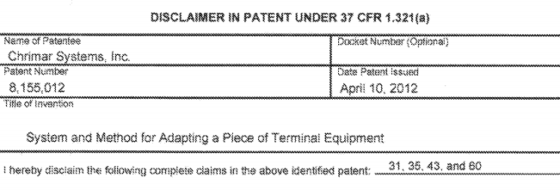Federal Circuit’s Quirky (and Incorrect) Doctrine of Retroactive Preclusion
Patent – Patently-O 2019-11-05
by Dennis Crouch
Chrimar Systems v. ALE (Alcatel-Lucent) (Fed. Cir. 2019)(en banc petition)
This case raises important Federal Courts questions that have had a major impact on patent law. Chrimar has petitioned for en banc rehearing and five amici briefs have been filed in support — all focusing on “the rules of finality that attach to an Article III judgment, when a later PTAB decision conflicts with that judgment.”
The current Federal Circuit rule stems from a 2013 decision captioned Fresenius:
A PTAB unpatentability decision takes precedence over prior court rulings and retroactively precludes those decisions so long as any issue of liability/damages remains pending in the court case, even if validity questions were waived or finally decided in the court case.
[This is my restatement of the holdings] See XY, LLC v. Trans Ova Genetics, 890 F.3d 1282 (Fed. Cir. 2018).
The en banc petition explains that the Federal Circuit’s preclusion rule is out of line with “every other circuit” and the Restatement (Second) of Judgments.
- Chrimar En Banc Brief
- Eagle Forum Brief (Schlafly)
- US Inventor Inc Brief (Morinville)
- USIJ, Center for Individual Freedom, and Conservatives for Property Rights Brief
- Brief of 14 Local Inventor Associations
- Brief of 20 Entrepreneurial Inventors
The difficulty for the Federal Circuit in this case is the 1922 Supreme Court case of John Simmons Co. v. Grier Bros. Co., 258 U.S. 82 (1922) that the briefs do a good job of explaining away (as does Prof. Paul Gugliuzza in his article (In)Valid Patents). “It is a stretch to claim, as the Federal Circuit has, that Simmons is controlling in modern cases involving inconsistent validity decisions by a court and the PTO.”
= = = =
Looking particularly at Chrimar’s case. In 2016, a jury sided with Chrimar against ALE — finding the patent infringed and not invalid. In a 2018 appeal, the Federal Circuit affirmed the damages award but modified the claim construction of one of the infringed claims (one of many). Chrimar I. On remand, the district court dismissed the challenged claim after Chrimar provided ALE with a covenant not to sue on that claim. ALE then appealed again — arguing that the disclaimer was insufficient because it did not expressly cover ALE’s customers. In response, Chrimar expressly expanded its disclaimer to make clear that it was a complete disclaimer of the claims (not just for ALE). 
Meanwhile, in 2018 the same claims at issue were all found unpatentable by the PTAB in an IPR brought by a separate party. Chrimar appealed that PTAB case that was affirmed without opinion (R.36 Judgment). Chrimar II. Relying on that R.36 Judgment, the Federal Circuit then vacated the jury verdict and district court damage award. Chrimar III. It is this final vacatur – Chrimar III – that is the subject of the en banc petition. Chrimar argues that the Federal Circuit was wrong to use the PTAB decision to collaterally and retroactively undermine the already final determination of the district court.